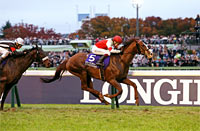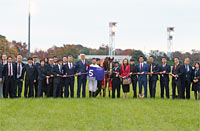Japan Cup (G1) - Data Analysis
Sparks will fly in this clash of Japanese and overseas heavyweights
The autumn middle- to long-distance racing season for veteran horses has at last reached its climax. Just ahead of the December program at Nakayama comes the Japan Cup, the big one to close the year at Tokyo. While this race attracts top horses from Japan and overseas, the last foreign entrant to savor victory here was British-trained Alkaased in 2005 - since when, Japanese horses have notched 10 straight wins. So, which of this year’s runners will see its name etched anew in the annals of the Japan Cup? In our search for clues, let’s analyze some trends in this race from results over the last 10 years.
Check the runners’ most recent race
First, let’s examine aggregate performances by runners over the last 10 years in terms of their most recent outing. Here, we find that 28 of the 30 Top 3 finishers in that time had most recently contested in either the “Tenno Sho (Autumn),” “Qatar Prix de l’Arc de Triomphe,” “Kikuka Sho,” “Shuka Sho,” or “Queen Elizabeth II Cup.” The remaining two were Ouija Board (previous race: Breeders’ Cup Filly & Mare Turf), finishing 3rd in 2006, and the 2008 winner Screen Hero (Copa Republica Argentina). In the last seven years, moreover, all of the Top 3 finishers have come from the five races mentioned above. This year, too, we should take a close look at the race most recently contested by the runners. [Table 1]
[Table 1] Performance by previous race (last 10 years)
| Previous race |
Performance
[1st-2nd-3rd-4th
or lower] |
Win ratio |
Top 2 ratio |
Top 3 ratio |
| Tenno Sho (Autumn) |
6-6-7-44 |
9.5% |
19.0% |
30.2% |
| Qatar Prix de l’Arc de Triomphe |
1-2-1-10 |
7.1% |
21.4% |
28.6% |
| Kikuka Sho |
1-1-0-9 |
9.1% |
18.2% |
18.2% |
| Shuka Sho / Queen Elizabeth II Cup |
1-1-1-6 |
11.1% |
22.2% |
33.3% |
| Other overseas races |
0-0-1-36 |
0% |
0% |
2.7% |
| Other races |
1-0-0-33 |
2.9% |
2.9% |
2.9% |
Beware the emergence of dark horses
Viewing performances over the last 10 years in terms of their favoritism to win this race, those backed as “1st favorite” have amassed an impressive record with a Top 3 ratio of 80.0%. But while the “2nd-5th favorite” horses have Top 3 ratios of 20.0-40.0%, those in the “6th-9th favorite” group also have a comparable ratio of 17.5%. This suggests that runners coming with a “dark horse” tag are by no means to be taken lightly. Nevertheless, horses in the “10th favorite or lower” group have not achieved a single Top 2 finish, suggesting that extremely low favoritism could signal ultimate failure. [Table 2]
[Table 2] Performance by favoritism (last 10 years)
| Favoritism |
Performance
[1st-2nd-3rd-4th or lower] |
Win ratio |
Top 2 ratio |
Top 3 ratio |
| 1st favorite |
3-3-2-2 |
30.0% |
60.0% |
80.0% |
| 2nd favorite |
1-1-2-6 |
10.0% |
20.0% |
40.0% |
| 3rd favorite |
1-1-1-7 |
10.0% |
20.0% |
30.0% |
| 4th favorite |
3-1-0-6 |
30.0% |
40.0% |
40.0% |
| 5th favorite |
1-1-0-8 |
10.0% |
20.0% |
20.0% |
| 6th-9th favorite |
1-3-3-33 |
2.5% |
10.0% |
17.5% |
| 10th favorite or lower |
0-0-2-76 |
0% |
0% |
2.6% |
Count the number of starts since the summer
Turning to performances over the last 10 years in terms of the number of starts since the summer, 27 of the 30 Top 3 finishers in that time had only “1” or “2” starts since July. We also find a big gap between the “1 or 2 starts” group and those with “3 or 4-plus starts” in terms of their Top 2 and Top 3 ratios. When comparing the runners’ preparation for this race, it would seem a good idea to watch for this kind of statistic. [Table 3]
[Table 3] Performance by number of starts since July (last 10 years)
| Number of starts |
Performance
[1st-2nd-3rd-4th or lower] |
Win ratio |
Top 2 ratio |
Top 3 ratio |
| 0 |
0-0-0-5 |
0% |
0% |
0% |
| 1 |
5-2-2-29 |
13.2% |
18.4% |
23.7% |
| 2 |
4-7-7-48 |
6.1% |
16.7% |
27.3% |
| 3 |
0-1-0-32 |
0% |
3.0% |
3.0% |
| 4 or more |
1-0-1-24 |
3.8% |
3.8% |
7.7% |
Look at the finish in turf race run over 2,200m or more
Viewing performances over the last 10 years in terms of the runners’ finish in their most recent turf race over distances of 2,200 meters or more, nine of the 10 winning horses turn out to have finished in the Top 3 in such a race. In terms of success ratios, too, the three groups with finishes of 1st to 3rd have amassed the better figures. We would do well not to overlook horses that have left a good mark in their most recent turf race run over this kind of distance. [Table 4]
[Table 4] Performance by finish in most recent turf race over 2,200m or more (last 10 years)
| Finish |
Performance
[1st-2nd-3rd-4th or lower] |
Win ratio |
Top 2 ratio |
Top 3 ratio |
| 1st |
5-2-2-31 |
12.5% |
17.5% |
22.5% |
| 2nd |
2-4-3-24 |
6.1% |
18.2% |
27.3% |
| 3rd |
2-0-0-9 |
18.2% |
18.2% |
18.2% |
| 4th |
0-1-1-13 |
0% |
6.7% |
13.3% |
| 5th |
0-1-0-13 |
0% |
7.1% |
7.1% |
| 6th-9th |
1-2-3-27 |
3.0% |
9.1% |
18.2% |
| 10th or lower |
0-0-1-21 |
0% |
0% |
4.5% |
*Horses that were disqualified in the race in question are counted as finishing last in that race.
*Jump races are not included.
Seek out the winner!
Winners all within the top six places in their last three outings
All nine winners since 2007 had come to this race finishing at least in the Top 6 in all of their previous three outings. When looking for a winner, our focus should be on horses that have maintained a consistent record in their recent racing performance. [Table 5]
[Table 5] Performance by lowest finish in the last three outings (last 9 years)
| Lowest finish |
Winning horses |
Horses placed 2nd or lower |
| Top 6 |
9 |
61 |
| 7th or lower |
0 |
87 |
(Michio Kawano)
|




















